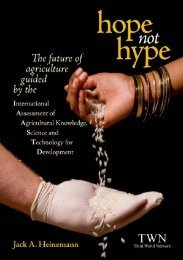gene Flow: Implications for Crop Diversity and Wild Relatives
gene Flow: Implications for Crop Diversity and Wild Relatives
gene Flow: Implications for Crop Diversity and Wild Relatives
- No tags were found...
Create successful ePaper yourself
Turn your PDF publications into a flip-book with our unique Google optimized e-Paper software.
of transgenic field trials, in federally-protected grassl<strong>and</strong>. Theecological consequences of such outcrossings are uncertain,yet any decrease in <strong>gene</strong>tic diversity would lead to a changein community structure with the introgressed regions. As aresult, in 2007 a federal judge ordered a temporary halt in newapprovals of GM field trials, citing an inadequate environmentalreview of the potential environmental impacts. 1 The rulingrequires that future GM trials in the US must undergo morerigorous environmental reviews.Whether or not any resulting <strong>gene</strong> flow has an evolutionarilysignificant effect on wild <strong>and</strong> weedy relatives must be testedcarefully. Few studies have directly addressed crop-to-wildtrans<strong>gene</strong> flow in the field (Linder & Schmitt 1995; Linder et al.1998; Bartsch et al. 1999; Spencer & Snow 2001; Gueritaine etal. 2002; Snow et al. 2003). Researching the impacts is difficult,as the selective value of a trans<strong>gene</strong> in a wild population maybe different within its ecological <strong>and</strong> biological context, wherea host of factors (including epistasis, <strong>gene</strong>tic drift, etc.) mayinfluence the magnitude of evolutionary impact. Nonetheless,cases such as with the a<strong>for</strong>ementioned creeping bentgrass signalthe need <strong>for</strong> more intensive research in this area.3.1.2 <strong>Crop</strong>-to-l<strong>and</strong>race <strong>gene</strong> flowGene flow between modern crops <strong>and</strong> l<strong>and</strong>races – the <strong>gene</strong>ticallydiverse domesticated, local, farmer-selected cultivars – has beenan area of concern since the early inception of modern plantbreeding. Many l<strong>and</strong>races are still being cultivated within theirareas of origin, <strong>and</strong> hence, local farmers play an important rolein the maintenance of in situ diversity <strong>and</strong> conservation (Gepts& Papa 2003). L<strong>and</strong>races act as important sources of <strong>gene</strong>ticdiversity – the <strong>gene</strong>tic stock that plant breeders must rely on1http://www.center<strong>for</strong>foodsafety.org/GTBC_DecisionPR_2_7_07.cfm accessed10 February 200713
















